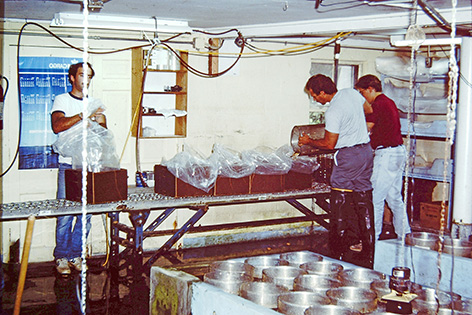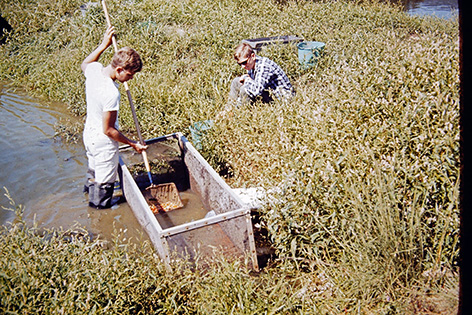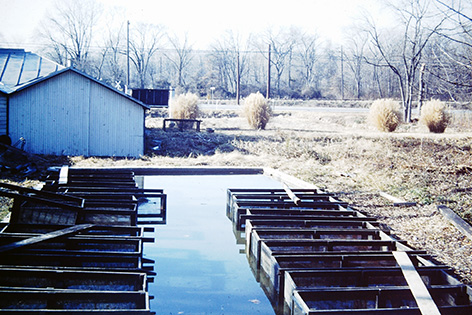Frederick County’s Golden Immigrants
by James Rada, Jr.
Note: This is part two of a series about goldfish farming in Frederick County.
The first record of a goldfish farmer in Frederick County is Charles J. Ramsburg. He was born and raised in Lewistown, but he attended college at Eaton and Burnett’s Business College in Baltimore. He returned to the family farm after he graduated in 1884. Part of his farming operations was to raise goldfish. By the early 1900s, he was shipping about a million fish a year around the country, according to History of Frederick County, Vol. 2.
Another pioneer in goldfish farming in the county was Ernest R. Powell of Lewistown. “When he was twelve years old, he began breeding goldfish, and was so successful in his enterprise that he increased his output every year, and is now one of the largest dealers of goldfish in Frederick County,” according to his biography in History of Frederick County. Powell would have been 12 years old in 1892.
More farmers began entering the business, using existing farm ponds or new ponds dug by hand with shovels, wheelbarrows, and horse-drawn scoops.
“In the early part of the century, I think people in the county, especially farmers, saw goldfish as a way of making extra money,” Ernest Tresselt said in an interview 2006.
He said the reason goldfish farming flourished in the county is unknown, “but it appears to be related to the availability of water on many farms because of the mountain streams and springs. The temperate climate, with its distinct seasonal changes, is ideal for the propagation of goldfish.”
George Leicester Thomas, who founded Three Springs Fisheries in 1917, had his own ideas about why goldfish were successful in Frederick County. He said in interviews that the water in Frederick County was well-suited for goldfish, perhaps because of the mineral content. It gave Frederick County the reputation for having the best-colored goldfish in the country, according to The Frederick Post.
Thomas’ grandson, Charles, said in 1981 that the rich-colored goldfish came because the county farmers used good breeding stock, but he also notes they lived in nutrient-rich water from truckloads of manure dumped in the ponds.
“The manure has nutrients that fish thrive on and actually all they have to do is open their mouths in order to eat,” said Charles Thomas.
George Thomas started his business as a roadside stand that sold vegetables and goldfish. This grew into Three Springs Fisheries in Buckeystown and is known today as Lilypons.
While customers may have bought his vegetables, they showed more of an interest in his goldfish. By the end of World War II, Lilypons had become the world’s largest producer of goldfish.
Hunting Creek Fisheries near Thurmont was started by Frederick Tresselt in 1923. Frederick Tresselt was a graduate of Cornell and had worked at the state trout hatchery in Hackettstown, New Jersey.
“In driving around the county with a friend in 1922, Dad was amazed to see all the goldfish ponds in the area,” Ernest Tresselt said.
Other Frederick County goldfish farmers included George English, Frank Rice, Earl Rice, Maurice Albaugh, M.H. Hoke, Ross Firor, Sam Eaton, David and Adam Zentz, Walter Rice, Joseph Weller, Richard Kefauver, and Martin Kefauver.
“Every farm that could had fish ponds,” Tresselt said. “It was a cash crop for them.”
Tresselt believes that Frederick County might not have the oldest goldfish farms in the country, but the county did have the most goldfish farmers. At the peak of goldfish farming in the county (the 1920s and 1930s), he estimates that as many as 30 or more farms were raising goldfish. The county had enough farmers that they organized as the Goldfish Breeders Association of Frederick County in 1920 to fight against the high cost of shipping.
The 1925 News-Post Yearbook and Almanac listed the county’s production at three-and-a-half to four million goldfish on 400-500 acres. Production in 1932 was seven million goldfish on 500-600 acres.
The 1925 yearbook notes, “They [goldfish] are marketed at from $10 to $50 per thousand, value of yearly production being about $75,000.”
In 1932, goldfish up to two-and-a-half inches long were sold for about $3.50 per 100 and retailed for five cents apiece, and larger goldfish sold for about $7 per 100 and retailed for 10 cents apiece. By this time, most reports estimated Frederick County farmers had been raising goldfish for about 50 years and had brought $1.5 million into the county, according to the Frederick Post.
By 1931, the U.S. Commerce Department said the United States goldfish industry was a $945,000 business in the country and, at that time, 80 percent of that was coming into Frederick County.
Early goldfish farming was relatively simple. In the spring, farmers stocked their ponds with breeder goldfish. The goldfish reproduced and the young grew through the summer and were harvested in the fall. The breeders were kept in the deepest ponds, since these ponds provided a good water supply over the winter.
In the fall, buyers would come driving trucks full of fish cans and buy the fish or farmers would ship the fish to the buyers. A single farmer would ship thousands of fish each day during the harvest. During the 1904 harvest season, goldfish farmer M.H. Hoke was shipping about 6,000 goldfish each day that he harvested from his ponds near Walkersville.
Once the crop was harvested, the farmers would drain their ponds and dry them over the winter as a means of sterilizing them. Feeding the fish was kept at a minimum. Generally, some form of ground grain, like wheat middlings or ground corn, was the food of choice. Treatments for parasites and diseases were marginal. As the ponds became older, there was an increase in a parasites problem. Another problem involved the weather. Ponds located on streams could flood, sending hundreds of fish and dollars into the stream.
Crayfish were also said to bore holes in the sides of man-made ponds, which could cause them to leak and eventually break. In 1904, one of Richard Kefauver’s Middletown ponds broke, and it was estimated he lost about $700 in goldfish, the Frederick News reported.
Other natural problems included fish cranes, hawks, kingfishers, and water snakes, all of which had a taste for goldfish.

Packing goldfish at Hunting Creek Fisheries.

Cleaning the catch boxes in the goldfish ponds.

The old fish house at Catoctin Furnace in the 1960s.

